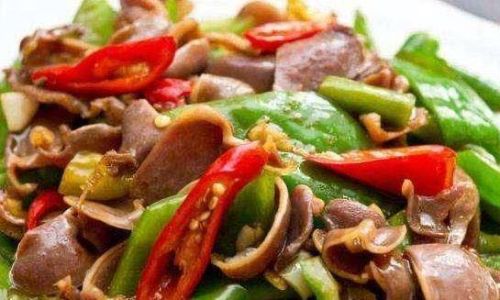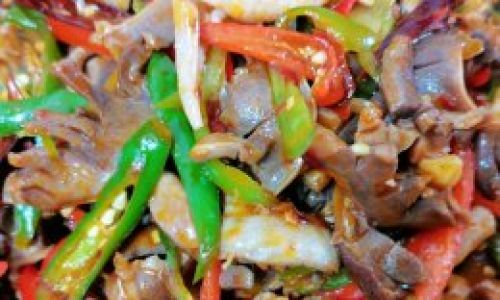In the vibrant tapestry of Sichuan cuisine, where fiery flavors and bold aromatics reign supreme, one dish stands out for its textural contrast and addictive spice: Spicy Stir-Fried Chicken Gizzard, or Bào Chǎo Jùn Gān in Mandarin. This humble yet revered dish transforms a often-overlooked poultry byproduct into a culinary masterpiece, blending tender chewiness with a symphony of heat, numbness, and umami. For those unfamiliar with the wonders of Sichuanese gastronomy, this dish offers a thrilling introduction to the region’s philosophy of má là (numbing-spicy) flavor profiles. Let’s delve into the history, craft, and cultural significance of this beloved street food and banquet staple.

The Origins of a Culinary Icon
Chicken gizzards, the muscular organs birds use to grind food, have long been a staple in global cuisines, from Southern fried giblets in the American South to giblet gravy in European festive meals. Yet in Sichuan province, a region renowned for its fearless use of chili peppers and Sichuan peppercorns (huā jiāo), the gizzard found its ultimate purpose. Local chefs, ever-innovative in their quest to elevate humble ingredients, recognized the gizzard’s unique potential: its dense, slightly rubbery texture, when cooked correctly, could absorb flavors like a sponge while offering a satisfying chew.
The dish’s rise to fame parallels Sichuan cuisine’s global emergence in the late 20th century. As Sichuanese migrants spread across China and the world, Bào Chǎo Jùn Gān became a symbol of the province’s culinary identity—a dish that thrives on contrasts. The gizzard’s resilience is softened by marinades, seared to lock in juices, and tossed in a whirlwind of spices that tickle the tongue with electric heat and citrusy numbness. Today, it graces menus from Chengdu’s bustling night markets to high-end restaurants in New York and London, proving that sometimes, the most unassuming ingredients can become stars.
The Anatomy of Flavor: Ingredients and Techniques
Crafting Spicy Stir-Fried Chicken Gizzard is an exercise in precision and balance. The dish’s allure lies in its layered complexity, achieved through a meticulous selection of ingredients and a masterful cooking technique known as bào chǎo—a high-heat stir-fry that sears ingredients rapidly, preserving their texture and flavor.
The Star Ingredient: Chicken Gizzards
Unlike tender chicken breast or thigh, gizzards require special preparation. First, they are cleaned meticulously to remove any grit or silverskin. Next, they are thinly sliced against the grain to ensure even cooking and tenderness. Marinating is crucial: a mixture of soy sauce, Shaoxing rice wine, cornstarch, and white pepper tenderizes the meat while infusing it with savory depth. Some chefs add a pinch of baking soda to further soften the fibers, though traditionalists argue this compromises the gizzard’s natural chew.
The Fire Triad: Chilies, Sichuan Peppercorns, and Aromatics
The dish’s signature heat comes from a trio of ingredients:

- Dried Red Chilies: Preferably er jing tiao or chao tian jiao, which provide a smoky, moderate heat without overwhelming bitterness.
- Sichuan Peppercorns: These prickly berries impart a citrusy, tingling sensation that dances on the tongue, counterbalancing the chili’s burn.
- Aromatics: Fresh garlic, ginger, and scallions form the flavor base, their pungency mellowing into sweetness as they caramelize in the wok.
The Sauce: Umami Bomb
A blend of fermented black bean paste (doubanjiang), soy sauce, oyster sauce, and a touch of sugar creates a glossy, savory-sweet coating that clings to every gizzard slice. Some recipes incorporate a splash of Chinkiang vinegar for acidity, cutting through the richness.
The Wok Technique: Speed and Fire
Bào chǎo demands a scorching-hot wok and split-second timing. The gizzards are seared first to develop a golden crust, then set aside. The wok is recharged with oil, and aromatics are fried until fragrant. Chilies and peppercorns follow, their oils infusing the oil. The gizzards return, tossed vigorously to absorb the flavors, before the sauce is drizzled in to create a lacquered finish. The entire process takes under three minutes—any longer, and the gizzards risk toughening.
The Sensory Experience: Texture and Taste
What sets Spicy Stir-Fried Chicken Gizzard apart is its textural symphony. Each bite offers a interplay of soft and crisp, tender and chewy. The gizzard’s slightly springy resistance yields to a burst of spicy juice, followed by the numbing buzz of Sichuan pepper. The dish’s heat is not aggressive but persistent, building gradually to a pleasant glow. This balance makes it addictively moreish—perfect for pairing with cold beer or steamed rice.
The dish’s aroma is equally captivating: the toasty scent of fried chili and peppercorns mingles with the sweetness of caramelized garlic, creating an olfactory preview of the fireworks to come. Visual appeal matters too—the gizzards glisten in a ruddy sauce, dotted with fiery chili segments and speckled with green scallions.
Cultural Significance and Modern Adaptations
In Sichuan, Bào Chǎo Jùn Gān is as much a cultural touchstone as it is a meal. It thrives in dà pá dǎo xiāo (big tray stir-fry) restaurants, where diners gather around sizzling woks to share communal plates. Street vendors push carts piled high with steaming gizzards, their spicy aroma luring passersby. The dish’s affordability and bold flavors make it a favorite among blue-collar workers and foodies alike.

Yet, like all classics, it has evolved. Modern chefs experiment with additions like diced celery for crunch, preserved mustard greens for tang, or even chocolate chili oil for a decadent twist. Some health-conscious cooks reduce the oil or use air-frying techniques, though purists scoff that such modifications dilute the dish’s soul.
Globally, the dish has inspired fusion creations. In New York, a Sichuan-Mexican fusion restaurant serves gizzard tacos with pickled onions and lime. In London, a pop-up pairs it with craft beer brewed with Sichuan peppercorns. These adaptations speak to the dish’s versatility—its core flavors transcend cultural boundaries.
Health and Nutrition: A Guilty Pleasure with Benefits?
While Spicy Stir-Fried Chicken Gizzard is hardly a health food, it offers surprising nutritional merits. Chicken gizzards are rich in protein, iron, zinc, and vitamin B12, making them a nutrient-dense choice. The dish’s spices also offer potential benefits: capsaicin in chilies may boost metabolism, while Sichuan peppercorns contain antioxidants. However, the high sodium content from soy sauce and the dish’s typical oiliness mean moderation is key.
For those with dietary restrictions, alternatives exist. Duck gizzards offer a richer flavor, while mushrooms or tofu can mimic the texture in vegetarian versions. Gluten-free soy sauce substitutions cater to celiac diners without sacrificing flavor.
The Art of Pairing: Wines, Beers, and Beyond
In Sichuan, Bào Chǎo Jùn Gān is often paired with lào chá (pu-erh tea), whose earthy notes cut through the dish’s richness. However, beer is the quintessential companion—a crisp lager or wheat beer cleanses the palate between fiery bites. For adventurous drinkers, a riesling with residual sugar or a lightly sparkling pétillant naturel wine provides a refreshing contrast.

Cooking at Home: Tips for Perfection
Recreating this dish at home requires patience and the right tools. A carbon-steel wok conducts heat efficiently, while a high-smoke-point oil like peanut or grapeseed ensures the aromatics fry without burning. Key tips include:
- Slice thinly and uniformly for even cooking.
- Marinate adequately—at least 30 minutes, but overnight is ideal.
- Control the heat—too low, and the gizzards stew; too high, and the spices scorch.
- Toss vigorously to coat every piece in sauce.
For those畏惧 (wèi jù, or “afraid of”) spice, reduce the chili quantity but retain the Sichuan peppercorns for flavor complexity.
Conclusion: A Dish That Defies Borders
Spicy Stir-Fried Chicken Gizzard is more than a meal—it’s a testament to human ingenuity, transforming a functional organ into a culinary delight. Its enduring popularity lies in its ability to delight, challenge, and unite. Whether enjoyed in a Chengdu alleyway or a Brooklyn kitchen, this dish embodies Sichuan’s culinary ethos: fearless flavor, textural adventure, and the joy of sharing a meal that sets the taste buds ablaze. So the next time you spot Bào Chǎo Jùn Gān on a menu, dare to indulge—your palate will thank you.





0 comments